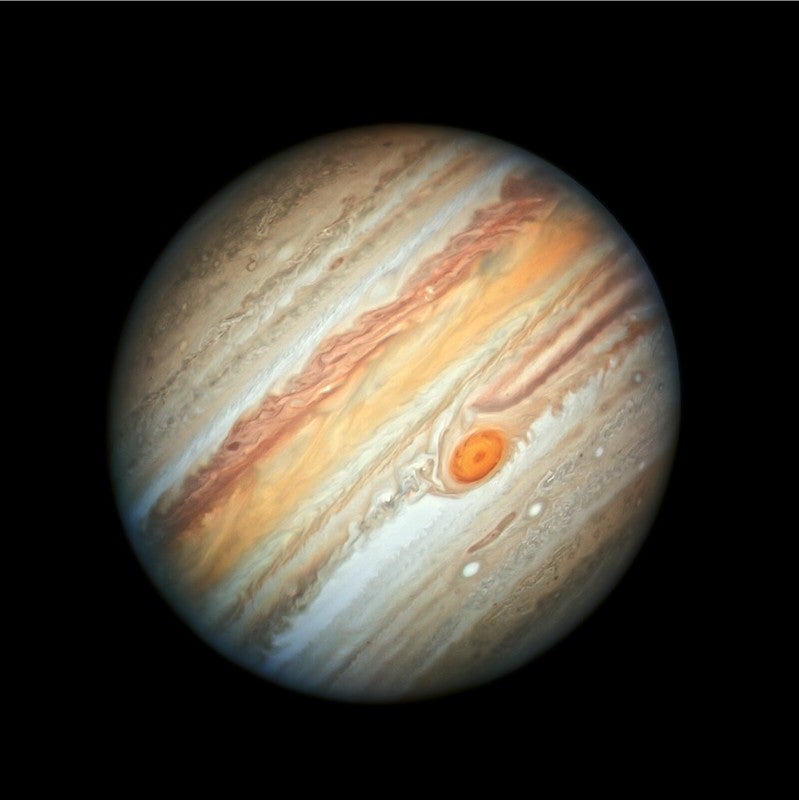
How old is each planet? Do we know the order in which the planets in our solar system formed?
Robert Hawk
Canal Winchester, Ohio
Estimating ages of specific events is one of the most difficult problems in astrophysics. While we have a precise (and probably accurate) age for the solar system, we do not have precise ages for each planet.
The solar system’s age comes from radiometric dating of rock samples from Earth, the Moon, and meteorites. If an isotope of one element decays into an isotope of another element, then measuring the ratio of both to a stable isotope of either element lets you work backwards to determine how many half-lives have passed since the initial concentration. (One half-life is the time it takes for half of a radioactive parent isotope [or radionuclide] to decay into its product, or daughter, isotope, with half of the parent remaining.) This only works for situations where elemental concentrations do not get mixed up between different material samples (e.g., the system is “closed” — adding in fresh material with different initial values of the radiogenic material, or indeed bulk elemental composition differences, will invalidate the analysis), one has radioactive elements of the right half-life, and these elements are in large enough concentrations to measure. Using this technique, we find that the absolute age of Earth is 4.54 billion years old, with an uncertainty of only 1 percent.
We can also determine relative ages of various rocks using extinct radionuclides, such as aluminum-26 (which decays into magnesium-26), whose half-life is so short (0.72 million years) that its original concentrations are now unmeasurable. The clock is usually set by the initial concentrations found in calcium-aluminum-rich inclusions, or CAIs — the first solids in the solar system — in meteorites, and we can measure ages relative to those. This technique gives relative ages good to half a million years for rocks from the first 10 million years of the early solar system (such as meteorite fragments or interplanetary dust grains). Other isotopic systems with different half-lives can be used to date specific events, like the formation of Earth’s core, which is related to the giant impact that formed the Moon.
Our best guess is that the gas giant planets — Jupiter and Saturn — formed first from the gas-rich disk that accompanied the formation of the proto-Sun. Of the planets, Jupiter and Saturn’s compositions are most like the Sun. However, even they have higher concentrations of heavy elements (beyond hydrogen and helium on the periodic table) compared to our Sun. This is evidence that even early on, solid materials that formed from these heavy elements — like silicon-oxygen-rich and carbon-rich dust, as well as ices that form at various distances from the Sun — play an important role in planet formation.
We suspect that the ice giants Uranus and Neptune formed next because they have gas-to-dust ratios intermediate between the big gas giants and the rocky terrestrial planets (Mercury, Venus, Earth, and Mars). Uranus and Neptune likely formed just as the gas disk that accompanied the forming Sun was dissipating, on a timescale of less than 10 million years. Next to form were the rocky inner planets. While their initial building blocks probably came together quickly to form planetary embryos, it took between 10 million to 100 million years after the gas disk was gone for these building blocks to further crash into each other and form the terrestrial planets we know today. We can estimate the time since a terrestrial planet’s surface was last “reset” (e.g., globally altered, such as by lava flows) based on crater counting, but those times are not formation ages. And finally, the dwarf planets in the outer solar system are still growing slowly.
Nailing down this sequence of events is of consequence for exoplanetary systems as well, which we can study with both theoretical models and observations. A Jupiter-like gas giant that forms early beyond the ice line (where it is cold enough for volatiles like water, ammonia, and carbon dioxide to exist as ices) probably has a strong impact on the delivery of water and other materials to potentially habitable planets. The evolution and final architecture of planetary systems have a lot to tell us about how planets form, as well as the prospects for life in the universe.
And, of course, we still have a great deal to learn when it comes to our own solar system as well.
Michael Meyer
Professor of Astronomy, University of Michigan Ann Arbor, Michigan









